GoedWare 14 Devlog (spoilers discussed)
Intro and Brainstorming
This GoedJam is an exciting milestone for me since it's the first time I have released a detective mystery game. While I have experimented with the genre before, this is the first time I managed to finish and upload a game for it. If I had to give a reason why I had not been able to before, I would blame overscoping and just the complexity of detective games in general.
I picked a story idea pretty quickly – a plot I had thought up recently for a closed room mystery game in which a painting gets stolen from an art museum and the culprit is the owner who had hoped that like the Mona Lisa, the painting would become more valuable after being stolen. Incorporating “Everything is a Resource” was a bit tricky. At first all I could think was to give the character a time limit or limited number of turns, but I honestly don't like games that limit your actions and it felt it would add too much complexity to an already complex game in a genre I was not experienced with.
My second thought was to have the characters describe things around them/related to their professions as resources. I scratched this idea because it felt like I was making a bare minimal effort to shoehorn the theme in and I wanted the connection to the theme to be something the player could interact directly with, like part of the mechanics.
I can't recall how I got the idea of a setting where information/info is traded as currency, though it may have been sparked by the various ideas Goed mentioned in the theme discussion (thanks!). As soon as I though if it, I knew it was the right theme. Detective games are already focused on collecting information, so why not have some of that info be used as currency to get clues? (I suppose because it creates another layer of complexity, but in the end it was setting up the mystery itself that proved to be the hardest part of development.)
Designing the Game
As I have iterated, I knew by instinct this was going to be a complicated game to set up, so I determined that I would avoid putting too much time into anything beyond the mystery and info. I chose RPG Maker MV because of the softwares I use, it is simplest for setting up gameplay and dialog, as well as being web exportable. It also has a lot of built-in assets and an easy mapping system that would save me having to look for and edit assets. I briefly entertained the possibility of making or adding some unique paintings to the gallery, but decided it was going to be safest to stick with the default MV paintings.
Characters
My initial list of suspects that I typed in my premise notepad were:
Owner/business-man/husband:
Owner/artist/wife:
Janitor/reformed art thief:
Janitor friend/pastor:
Reporter(sneaked in):
Of these original five suspects, only three made the cut. The pastor was cut almost immediately because he felt redundant with the janitor and I did not want to set up another character, their list of questions and responses to clues. His reason for being in the locked museum was that the janitor had called him because she was having one of her old urges. The only other roll he had was donating money to the museum in the janitor's name, a point I kept through a statement by the janitor despite the pastor's presence being cut before I even made a character design for him.
The second character was not cut until the middle of the jam, when I decided having the reporter hiding in the basement was going to add too much complexity and cutscenes. I really regretted this because not only was she a fun character to write, she also allowed for more lore and world building to be added, especially in regards to the reporter profession and how they (kinda) got along with detectives. I eventually added this back to some extent by putting her on street corner in the second scene as a random NPC with some minor world building dialog.
Character Design
I made the main characters in MV's character generator. If you are not familiar with the generator, it comes with many interchangeable clothes, hair styles, face expression, etc. that can be used to make walk sprites, battle sprites and face portraits.
I did not know for certain what my characters would look like, but had some general ideas. The detective needed to look relatively ordinary, with perhaps a slightly edgy appearance and an unshaven beard. I ended up giving him unkempt light brown hair with a leather jacket and red undershirt for color. The owner of course needed to look like a professional business man in a suit. I gave him some well kept blue hair (more professional sounding than it looks) and some glasses to add to the effect. The artist needed an eccentric artist look. I ended up giving her some wild pink hair, big contrasting green eyes and an edgy modern outfit.
At this point, choosing clothes was becoming difficult, since most of them had either a medieval or combat vibe and most of what remained were either suits or school uniforms. This was especially hard because I had just reached the character with the strictest design requirements: the janitor-guard/reformed art thief who had discovered religion. I thought I was going to give her the casual shorts and sweatshirt outfit until I noticed it was open at the front revealing a bra/combat bikini. The janitor would never dress like that. I ended up swapping for a nondescript green combat uniform that felt like it could technically fit a janitor-guard position without looking too out of place.
Finally, it was time for the reporter. I gave her a wide brimmed brown hat and suit to help her look the part and big bright adventurous eyes. I also ended up making a portrait for the police chief.
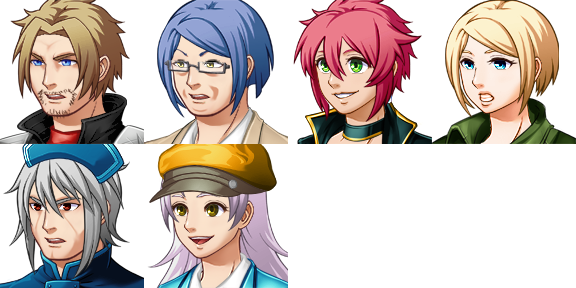
You may have noticed by now I have not used any of these characters names. The detective never gets one because I started the intro scene before I even started character designs and it was not feasible to go back and change “Detective” to an actual name a hundred times over. As for the other characters, I chose their names pretty much at random after creating their designs – the owner being Dave Oliver, the artist Samantha (Sam) Williams Oliver, and the reporter Daphne Hill.
The one exception was the janitor-guard. Considering that she had changed her name after reforming, I felt she would choose something that was respectable and the opposite of her past. Angela felt like something she would want to be and Lovejoy is an actual last name that could represent her desire to spread love and joy as opposed to heartlessly stealing.
Room Design
Map creation always takes a surprising amount of time and this was my first time working with MV's modern tileset. Fortunately, I did not need many maps: the detective's office, the museum and the basement, though I soon realized I would also need a map outside the museum and a street map for when the detective is looking for a case. I made the office with little trouble and outside the museum came out okay, but struggled to design the museum interior, so I decided to edit one of MV's free sample maps. They did not have a museum, but they did have a couple nice modern rooms, so I choose the below room.
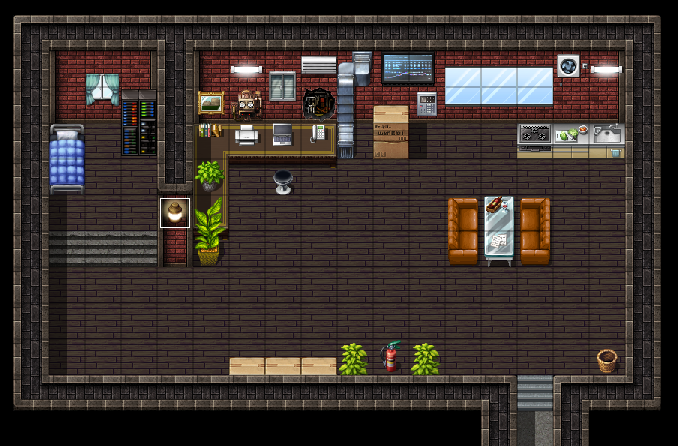
Unfortunately, I did not save any in between edits images, but in short, my steps to turn it into an art museum were to make the walls white, add steps leading down to an entryway, add new walls to section off various areas of the museum (the reception area, stage with statues, the artist Sam's array of paintings), and a hallway leading downstairs to the staff only basement. Adding all these required me to increase the room size a couple times and the end result is so different from the sample map I doubt the average player would even make the connection.
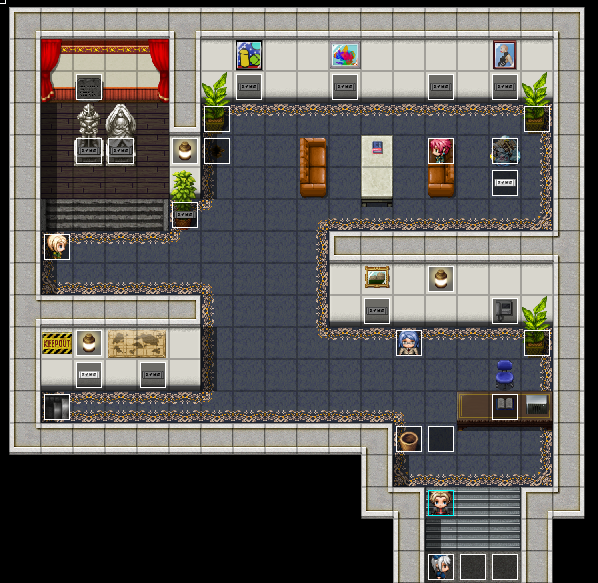
For the street scene, I also used a sample map, with much fewer modifications, it's basically the top left corner of one of the modern city maps with the park replaced with a parking lot and the “north” road replaced with a grass patch and food cart.
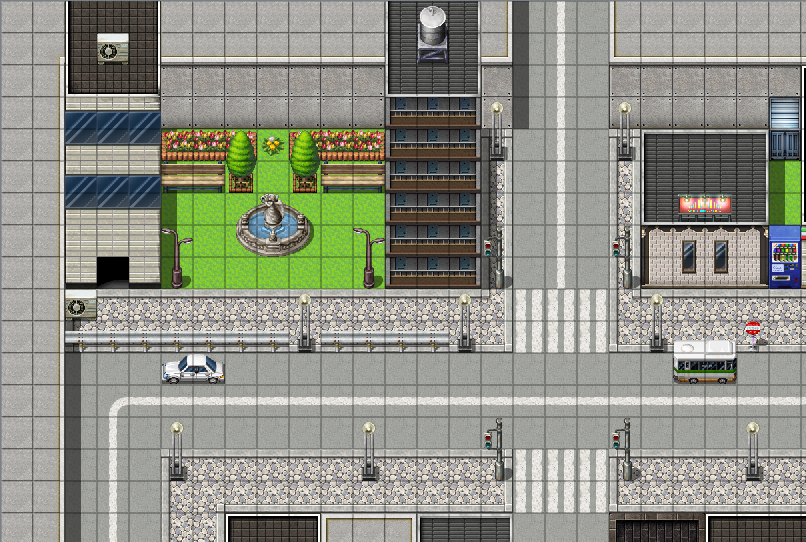
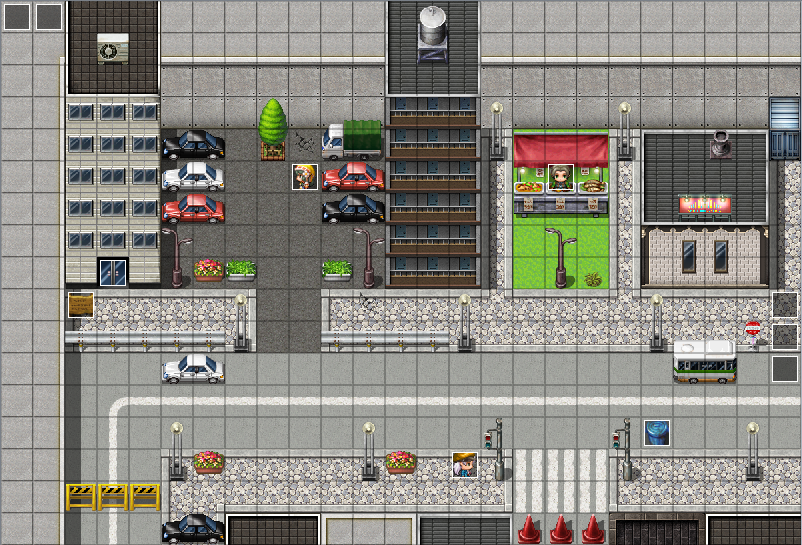
As for the basement, my major concern was for it to have the same “outline” as the upstairs part of the museum, minus the entry way at the bottom right, since I felt it was not part of the building's structure. So I copied the museum map, erased the entryway and upstairs items and changed the floor and walls to cement and metal before adding the bathroom office, flooded corner and machinery.
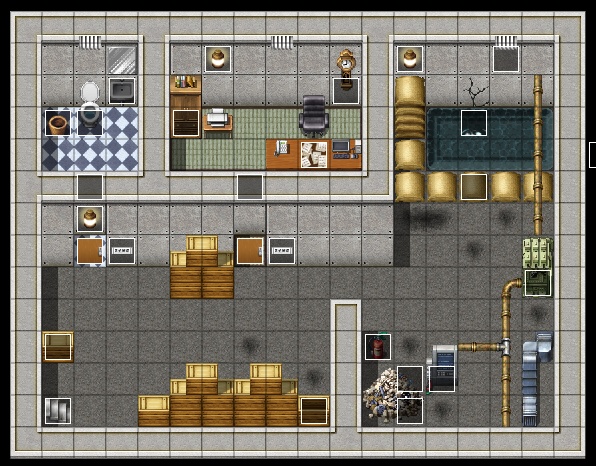
Introducing the mechanics
Since info was going to be such a central part of the game, I wanted to introduce this at the very beginning of the game along with basic exploration, so I used the detective needing to go out and find a case as a tutorial on how to find and trade info. I kept it simple, one person who had the info you needed, and one person who wanted the info you had AND had info that the first person would take.
Next I needed to introduce questioning and clues when the player arrived at the museum. I had to have the chief do a long “as you know Bob” type explanation of how to find clues and sell info that I would have preferred to explain through interacting with the environment, but time did not allow for it.
I am a little frustrated with how a lot of the game came out. I barely had any info to trade at the museum and the only place you could do it was the phone connected to the intelligence department. Dave, as the business focused owner, was supposed to also trade info with the detective, but I had to cut that for time.
Another casualty to time cuts is interactable clues. Initially, I was lamenting how to change dialog options based on what clues you had when I was reminded (by playing some detective games) that such games often give the players a clues window to select from while talking to the characters, so dialog for the clue could come directly from the clue itself. However, I was unable to add that, so clues are just icons you can look at and review.
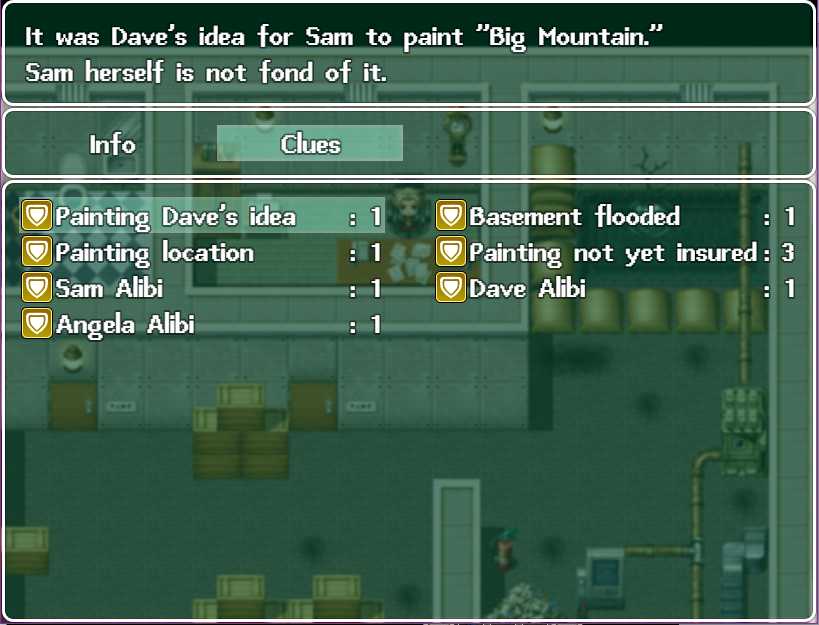
The Mystery
In the last few days of the jam, I suddenly realized I did not know where each suspect was at the time of the theft. I still did not have much questioning dialog set up, so it turned out there were a lot of plot points I still had to establish, but this was the biggest one.
I decided that Dave (the culprit) would have been in the basement office doing tax paperwork with his wife Sam (present at his insistence), though at the time of the theft, she would have been in the bathroom next to the office, and Angela would be upstairs. This worked until I noticed there was no spot Angela could be without seeing Dave walk by – except the statue stage, which is so close to the painting she would be close enough to catch him when the alarm went off. My solution was to have her be cleaning the front door. That way, she would be far away from the room and not facing the stairs, but she could hear someone come up (clue for the detective!).
The jam was nearly over by then and I had to accept that I was going to have to REALLY start cutting corners. No interactive clues, minimal info to trade and only one place to trade it and use the two major cut scenes to reveal some of the big clues instead.
The first of these cutscenes was finding the painting in the wall by the rip in the carpet. I decided to have Dave get angry when you try to do this and threaten to sue and Angela insist you should be respectful to museum property, while Sam is fine with it. After the painting is found, Sam reveals she is a bit disappointed because she did not like the painting and only made it because Dave told her too.
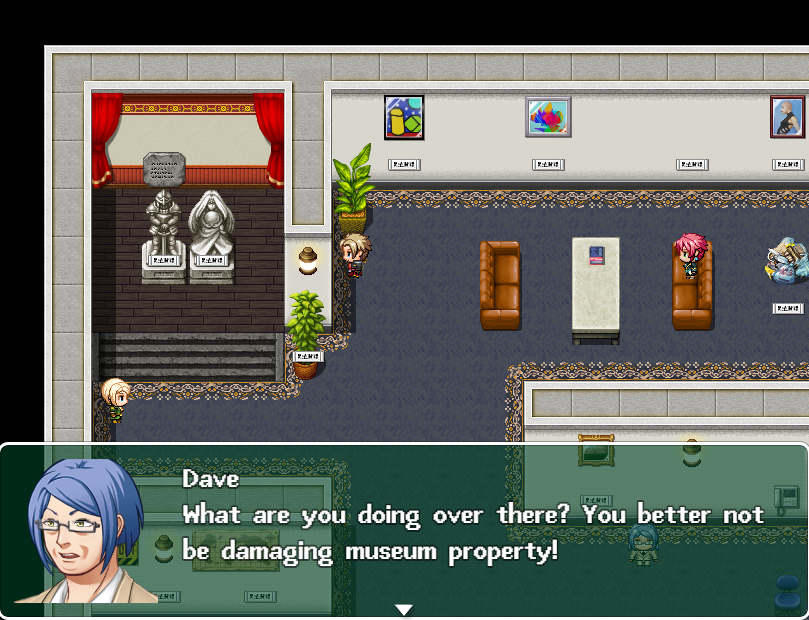
The second was not originally supposed to be a full cut scene ano longer steals art and that the museum had the fancy security system because she'd had her pastor donate some money to the museum she felt wrong donating herself because it was stolen money she had been unable to return to its rightful owner. Since I certainly did not have time for the detective to confirm this, I had to have the intelligence person get so invested in this discussion they look up the info as a freebie.
Finally, it was time to have the detective solve the mystery. I wanted to have a cutscene revealing the truth to the suspects, but this plan was yet another victim of the running gag of time cuts. Instead, I had the chief ask the player a series of questions, who answers strongly rely on the info from the cutscenes.
It's possible to trigger this any time by talking to the chief, so I started with asking where the painting was and adding as many choices as possible so that the player would not be able to guess too easily if they had not found the painting yet.
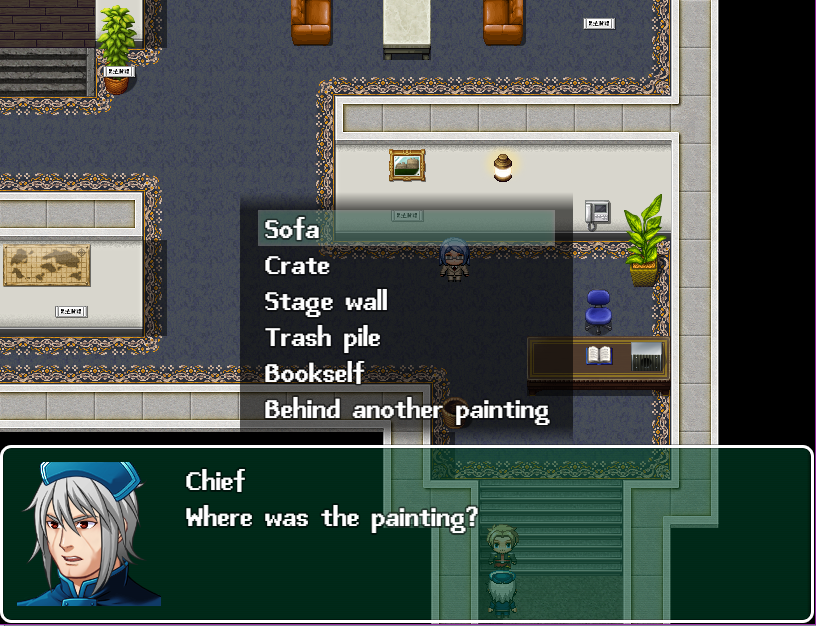
Next the motive, since that was a big part of the game's premise, and then whodunit. I decided to add “Somebody Else” to the list since Sam had tried to suggest the presence of a fourth person (and there originally was a fourth person).
Now the detective had to give his reasoning. I'm not as fond of it because he had to make a lot of general surmises based on Angela having given money to enhance the museum's security and the couple having the financial motive. Sam got to be in the clear because she wanted Detective to check the wall, yet was openly disappointed he found the painting and seemed less concerned about money compared to Dave, who has a book about the theft of the Mona Lisa in his office and was desperate to pin the theft on Angela. While some of these points hit home, I also felt it had the vibe of some sleazey detective forcing the points in his favor because he wanted to close the case.
Summary
Despite the time cuts and general rushed nature of the game, I do like what I managed to submitted and was relieved to see commenters were enjoying the game. I do want to make some improvements post jam, possibly create a full version with all the suspects and maybe make a couple sequels since this info based universe has been giving me a lot of potential ideas. No idea if I will follow through, but it's definitely been a fun learning experience creating “Sealed Museum Mystery.”
Info City: Sealed Museum Mystery
Find clues and trade info to find out who stole the painting.
| Status | Released |
| Author | Kobato Games |
| Genre | Interactive Fiction, Adventure |
| Tags | Detective, Mystery, Point & Click, RPG Maker, RPG Maker MV, storygame, Story Rich |
Leave a comment
Log in with itch.io to leave a comment.